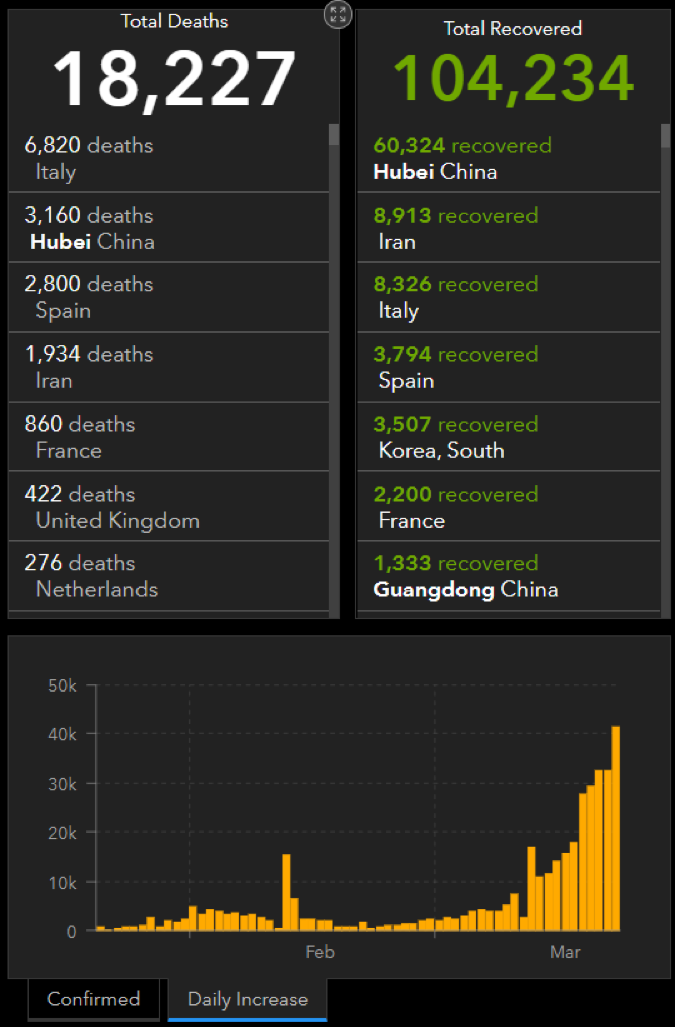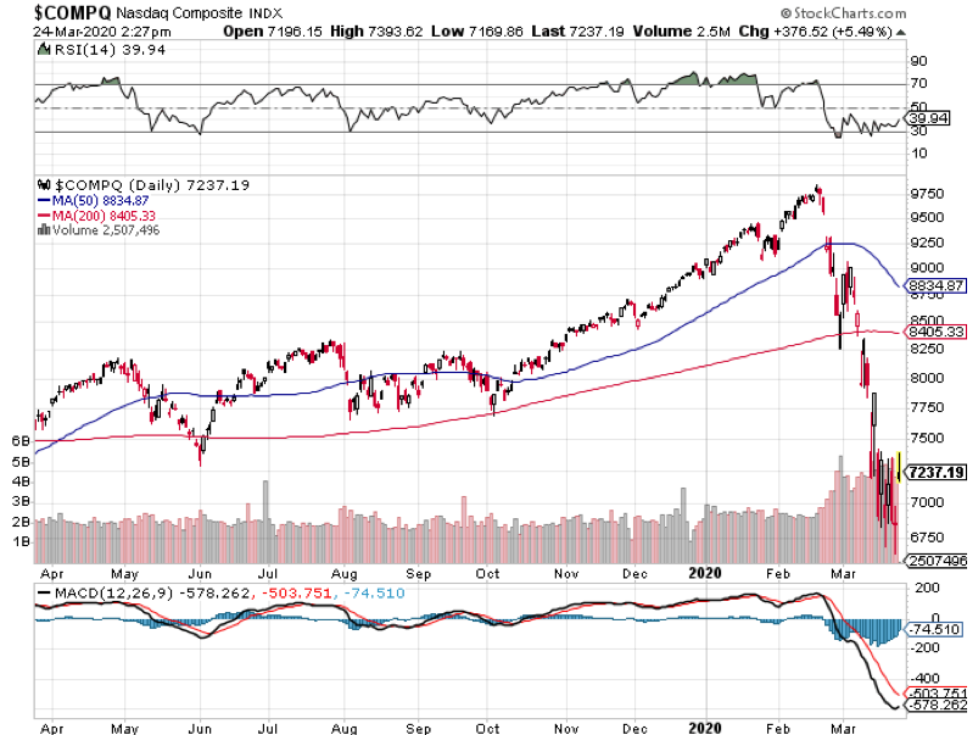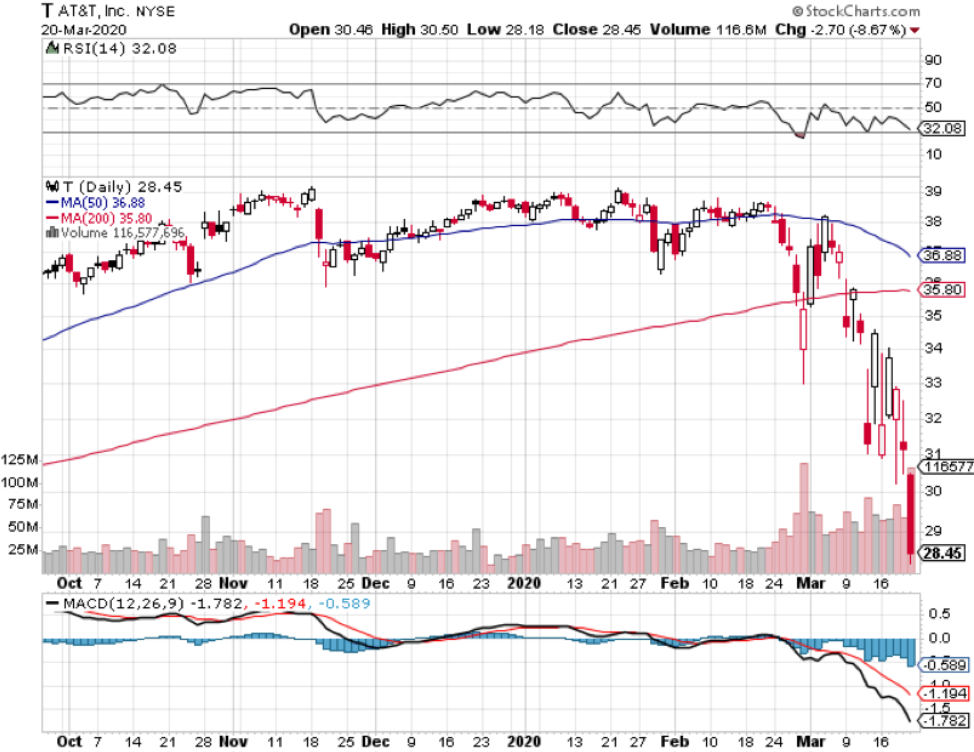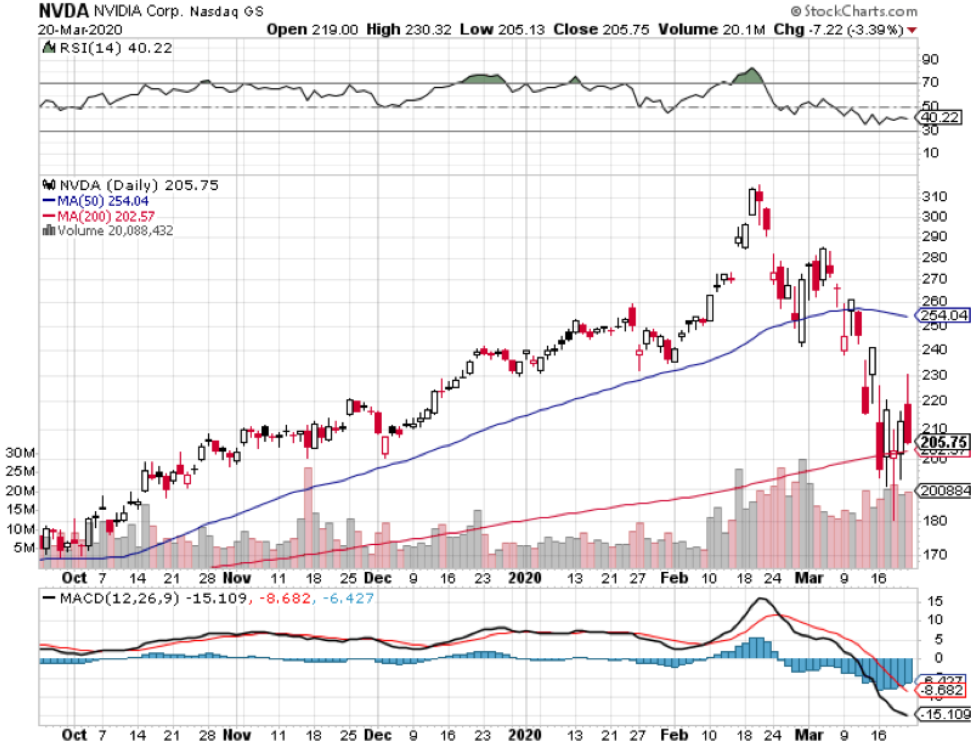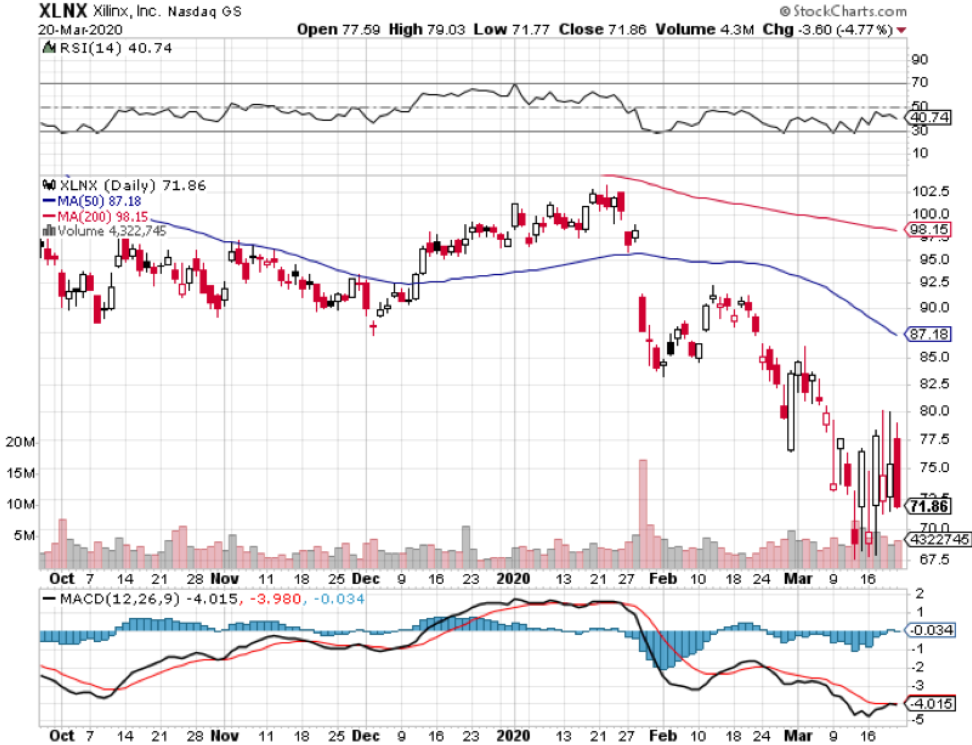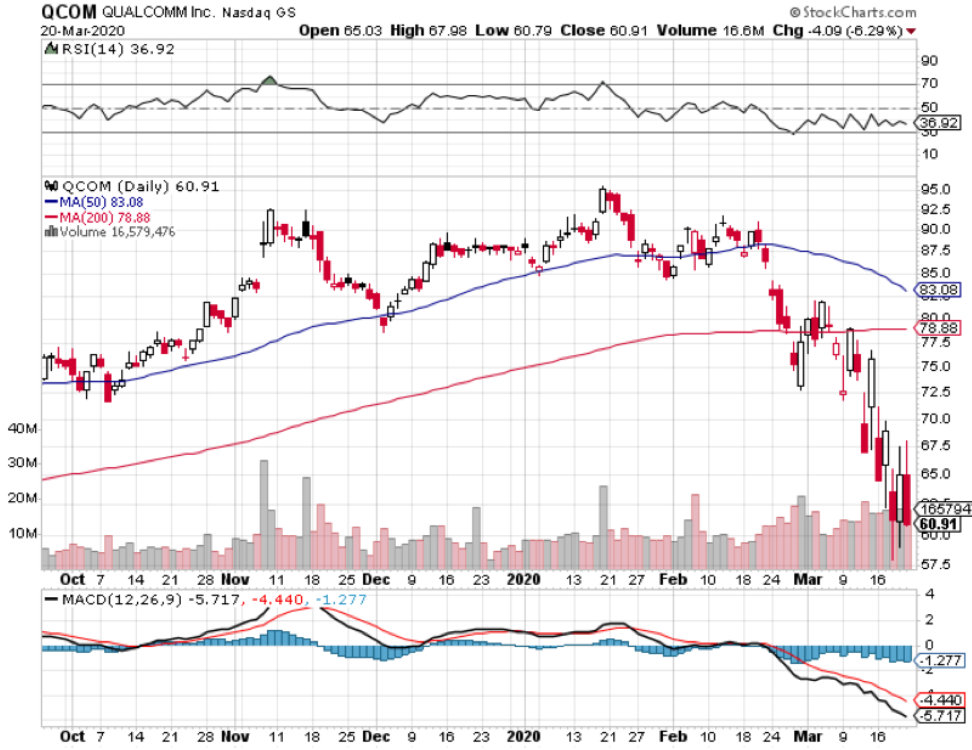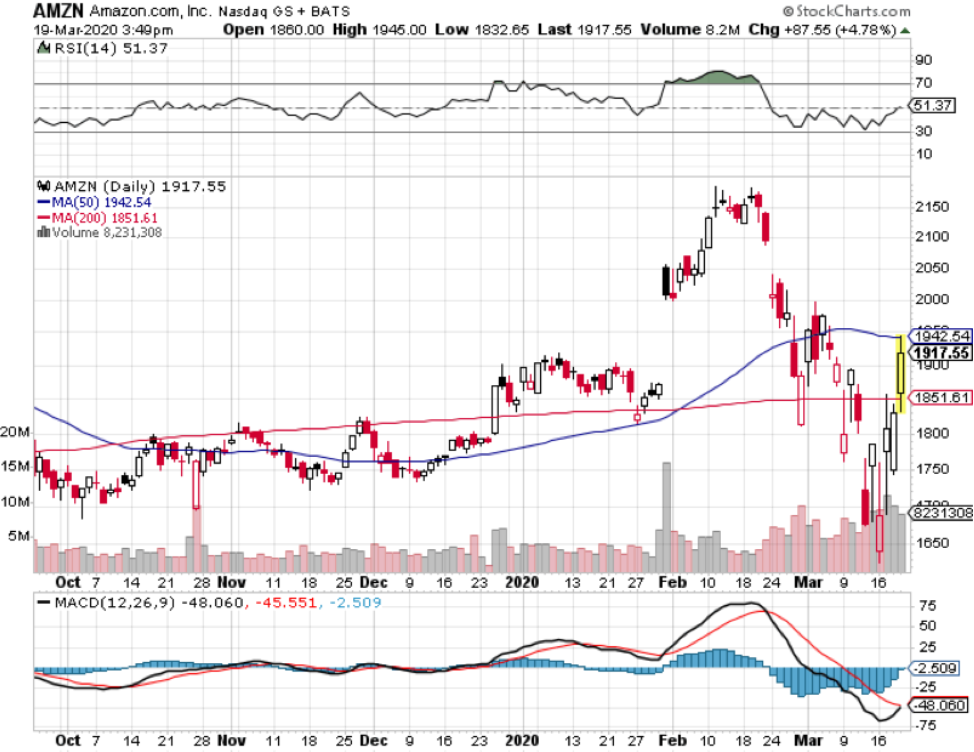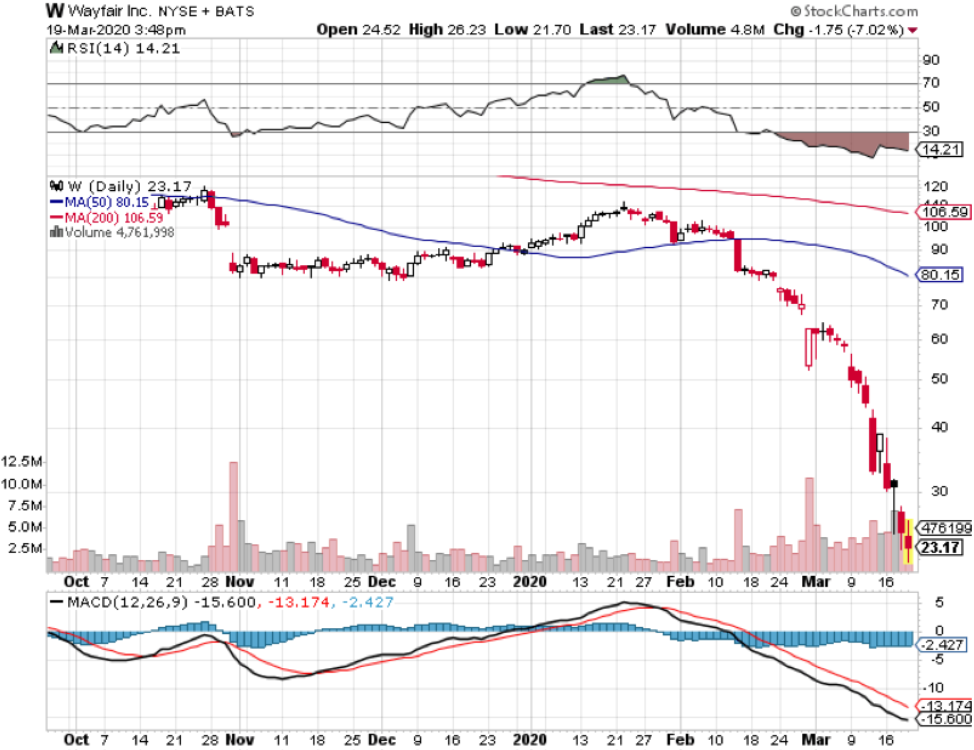“The thing that we are trying to do at Facebook is just help people connect and communicate more efficiently.” – Said Facebook Co-Founder and CEO Mark Zuckerberg
Mad Hedge Technology Letter
March 25, 2020
Fiat Lux
Featured Trade:
(ALGORITHMS RUN WILD)
($COMPQ), (TWTR)
Don’t underestimate trading algorithms.
The “Buy the Dip” psychology is broken and computerized trading has completely flooded the market with its personality.
That is exactly the dynamic of the current tech market, and it will mountain of generous offerings to reverse the trend in the form of monstrous stimulus and cash handouts.
As we entered 2020, the sentiment was sky-high, geopolitical tensions relatively calmed and three recent interest-rate cuts from the Federal Reserve drove tech stocks to record levels.
For 10 years, traders and the algorithms they harnessed were handsomely rewarded by aggressively betting against elevated volatility.
Cogent chart trends are the algorithms’ lustful partner in bed and now that every single short-term model is flashing sell, sell, sell - there isn't much bulls can do to fight back.
Many tech hedge funds have settled on similar conclusions - the best defense right now is unwinding portfolios to return to cash.
Incessant margin calls roiling any logical strategy has struck fear into many traders who levered up 10X.
What you could possibly see is the Minsky moment: That stability ultimately breeds instability because the only input in which becomes the difference make is volatility producing massive violence on upside and downside moves.
The ones who can absorb elevated risk are nibbling and unleveraged hoping to time the turn when stocks finally react positively to good data.
The current battle in the fog of war is that of two different economic scenarios that have direct influence in which ways the algorithms flip – either shutdown the country ala Wuhan, China for an extended period of time or send the troops back to work.
Hedge fund billionaire Bill Ackman gave his 2-cents restating his passionate plea for a 30-day-shutdown to fight the coronavirus pandemic.
Former Goldman Sachs CEO Lloyd Blankfein is in favor of sending back the asymptomatic younger generation workers sooner than later.
Initially, Blankfein gave his backing for “extreme measures” in order to flatten the curve, but promoted healthy workers returning “within a very few weeks.”
Blankfein's argument rests on that if people don’t go back to work, the economy might become too damaged to recover from inciting another crash.
This contrasts starkly with Ackman’s idea of “testing, testing, testing”, which would theoretically dismantle the potency of the virus but take longer for the economy to restart.
U.S. President Donald Trump has relayed his desire to open up business by Easter Sunday.
So as mostly professional politicians hash out a towering aid package of over $2 trillion, firms will get more of an indicator of how and when the business world opens up again.
Trading algorithms are on a knives edge because of the uncertainty – until they are illegal – it is something we are stuck with.
These trading formulas are preset based on biases that start with a series of inputs and the most critical input is volatility or better known as the fear index.
If the lockdowns are extended, the flood of negative news will force algorithms to sell on the extra volatility.
When things go bonkers, many of these preset formulas sell which exacerbates the down move further simply because more than enough people have the same preset algorithm.
Cutting position size when market volatility explodes is not a farfetched theory and is quite a common trading nostrum.
Even if many of these trades would be good long-term bets, many trading algorithms are focused on short-term trades and by this, I mean milliseconds and not days.
Another input into trading algorithms are Twitter feeds.
The platform is scraped for keywords from mass media news sources and synthesized into a specific output that is fed into a computer algorithm.
These headlines offer insight into what the sentiment is for the trading day – negative, positive, or neutral.
This scraping of data is especially relevant in today’s chaotic trading world where 10% moves up or down in one day is the new normal.
Because of Dodd-Frank Wall Street reform, many of the big banks have shuttered trading operations hurting the market’s liquidity situation causing spreads to widen and down moves to accelerate.
But now that the Fed has landed the Sikorsky UH-60 Black Hawk on the helipad and the money is waiting to helicopter down as they have announced “unlimited” asset buying and guaranteeing of corporate bonds to aid financial markets.
How does computerized trading roil markets?
Here is an example. A recent trading day included more than $100 billion of selling, the worst week since the financial crisis and was triggered by a hedging strategy called “vol targeting”—using volatility as a central input in trading decisions—and other systematic tactics.
Funds making decisions based on volatility, including some with names such as volatility-targeting funds and risk-parity funds, have risen in popularity.
Risk-parity funds manage an estimated $300 billion.
Risk parity is an approach focused on allocation of risk, usually defined as volatility, rather than allocation of capital.
That is what we have now – a cesspool of risk parity hedge funds layered by high frequency funds layered by short/long vol funds layered by arbitrage funds all levered 15X.
The take into consideration that they are supercharged by massive volume-based computer algorithms and trying to head for the exit door at the same time.
Ironically, this could be one of catalysts for shares to recalibrate and head back up north as traders start to front-run the peak of the health crisis.
Let’s hope that it happens sooner than later and that the government doesn’t manage to screw up delivering the helicopter money.
“If you can't make it good, at least make it look good.” – Said Co-Founder of Microsoft Bill Gates
Mad Hedge Technology Letter
March 23, 2020
Fiat Lux
Featured Trade: (THE CORONA DRAG ON 5G)
(VZ), (T), (AAPL), (NFLX), (NVDA), (XLNX), (QRVO), (QCOM)
It will be inevitable – the 5G shift in 2020 will be delayed.
Last year, 5G was available on only about 1% of phones sold in 2019 and demand has cratered this year because of exogenous variables.
Up to just recently, Apple (AAPL) was the bellwether of the success of tech with wildly appreciating shares due to the expected ramp-up to a new 5G phone later this year.
Well, things are more complicated now.
I will be the first one to say it - the new Apple 5G iPhone will be delayed until 2021 – the project has been thrown into doubt because of a demand drop off and headaches with the supply chain in China.
The phenomenon of 5G cannot blossom until consumers can upgrade to 5G devices.
Concerning all the media print of China Inc. going back to work, don’t believe a word of it.
People of the Middle Kingdom are sitting at home just like you and me by navigating around top-down government edicts.
Instead of the perilous commute in a country of 1.4 billion people, Chinese workers are fabricating attendance figures per my sources.
Overall data is grim - global smartphone shipments dropped 38% year-over-year during February from 99.2 million devices to 61.8 million - the largest fall ever in the history of the smartphone market and that is just the tip of the iceberg.
The new data point underscores the magnitude of how the coronavirus is sucking the vitality out of the tech ecosystem in China and thus the end market for global consumer electronics.
The statistic also foreshadows imminent trouble in the smartphone market as other regions have now shut down not only in China but the manufacturing hubs of South East Asia.
The outbreak squeezes both supply and demand.
Factories in Asia are unable to manufacture phones as usual because of obligatory government shutdowns and complexities securing critical components from the supply chain.
5G has been hyped up as the great leap forward for wireless technology that will usher in unprecedented new use cases supercharging global GDP — from driverless transport to robotic automation to smart football stadiums.
And coronavirus is just that Godzilla destroying 5G momentum down.
Mass quarantines, social distancing, remote work, and schooling have been instituted in American cities, meaning that the current network carriers are swamped and overloaded with a surge in data usage.
The Verizon’s (VZ) and the AT&T (T) Broadbands of America are currently focused on maintaining their current core customers, adding extra broadband to handle the increased load, and making sure the health of the network stays intact.
This is a poor climate to upsell products to beleaguered Americans who have just lost income and possibly their house because they cannot pay mortgages.
Services such as YouTube and Netflix (NFLX) have even decreased the quality of streaming on their platforms to handle the dramatic spike in extra usage in Europe with the whole continent locked down.
The Chinese consumer was the Darkhorse catalyst to ramp up the global economic expansion during the last economic crisis, picking up world spending in 2009.
On the contrary, this group of super spenders is less inclined to save the global economy this time around because they are saddled with domestic debt.
Just as unhelpful to Silicon Valley revenues, the technology relationship at the top of the governments are poised to worsen because of the health scare.
The U.S. administration has already banned the use of Chinese components in the U.S. 5G network amid suspicions the devices would be used for espionage.
Back stateside, I believe the U.S. telecoms will explicitly detail a sudden slowdown in the 5G network rollout during their next earnings report.
The telecom companies have been able to successfully handle the extra incremental load, but it has had to allocate resources to service the extra volume.
In the meantime, companies will shift to doing infrastructure and site preparation in anticipation of the re-build up to 5G, but that could be next to be put on ice if crisis management moves to the forefront.
Considering every 5G base station is being manufactured in Asia, one must be naïve in believing all is well and they will probably need to do what the 2020 Tokyo Olympics will shortly do – postpone it.
It’s not business as usual anymore.
This time it’s different.
The world just isn’t ready to digest such a shift in global business as 5G until the fallout of the coronavirus is in the rear-view mirror.
The 5G phenomenon underlying effect is to supercharge globalization into smaller networks of interconnectivity and that is not possible during a black swan event like the coronavirus which is the antithesis of globalization and interconnected business.
Just take the situation across the Atlantic Ocean in Europe, UBS Group AG, and Credit Suisse Group AG required clients to post additional collateral, and money managers in New York are preparing term sheets for ultra-rich Americans to urgently meet margin calls.
Many people are scurrying back to their doomsday’s shelter and that does not scream global business.
If you thought gold was the safe haven – wrong again – it experienced back-to-back weekly losses as margin pressures force fire sales of gold to raise cash.
Another glaring example are the assets of Eldorado Resorts Inc., controlled by the founding Carano family, which burned $28.7 million of stock in the casino entity to meet a margin call to satisfy a bank loan.
Things are that bad now!
Sure, telecom players might argue that a sudden influx of workers from home necessitates more investment in 5G, but if they have no income, all bets are off.
The capacity of 4G home broadband has proved it is good enough for today’s demands and it means the last stage of 4G will be a high data consumption longer phase before business lethargically pivots to 5G in 2021.
Verizon’s CEO Hans Vestberg said last year that half the U.S. will have access to 5G by the end of 2020, and I will say that is now impossible.
This sets up a generational buy in the Silicon Valley chip names involved in 5G after coronavirus troubles peak such as Nvdia (NVDA), Xilinx (XLNX), Qorvo (QRVO), and QUALCOMM Incorporated (QCOM).
“Once things start moving, Uber will, too.” – Said Current CEO of Uber Dara Khosrowshahi when asked about the fallout from the coronavirus
Mad Hedge Technology Letter
March 20, 2020
Fiat Lux
Featured Trade:
()
(AMZN), (W)
Social distancing signals the death of business in March and April 2020. Enter online shopping and E-commerce.
E-commerce’s greatest strength is pulling ahead of its competition while Millennials have also been the catalyst in turning the general shopping experience into a seamless digital affair.
And now that the world is at the mercy of an invisible virus, the use case for e-commerce business models has never been brighter, more appealing, and contactless.
That’s not to say that there are still net negatives from worker’s losing their jobs and being unable to buy goods, whether online or not. The overall damage to tech companies as a result of the pandemic cannot be ameliorated with a simple panacea.
The pain is just starting as the tech market searches for a bottom.
Covid-19 cases have mushroomed to over 11,200, and investors need to digest that continued underperformance lies ahead in the short-term.
But, the long-term migration towards digital models is looking better by the second.
Essentially, the e-commerce method is being supercharged by the coronavirus and the positive unintended consequences harvested by the e-commerce business models are directly correlated to increasing fatalities.
The health scare is ushering in a giant wave of new long-term customers who are just starting their digital experiences, making investing and e-commerce a topic worth discussing.
Astonishingly, the work environment has truly metamorphosized the past two weeks - any worker who can work at home is now working at home.
No longer do we have the hesitant boss who thinks working at home is all fantasy and no production.
Local policies have been so drastic in some cities that lockdowns of schools and restaurants have become commonplace.
People in those cities have also begun shunning public, crowded places in the name of health and survival.
How bad is it out there on the streets, and how poorly are U.S. tech firms doing?
The economic pain caused by the escalating coronavirus pandemic will be worse than the Great Financial Crisis of 2008.
The Chinese economy is contracting at a 15% annual rate, while the European economy is already in severe recession because of the drop off of China revenue.
In the U.S., they are shutting down restaurants, schools and major events; people are going to be without a paycheck, and this doesn’t set up nicely for consumers to pay for tech services that aren’t utilities.
Unless there are major policy moves soon, a downward spiral will usher in something akin to a global tech recession, and U.S. Secretary of the Treasury Steve Mnuchin is already ringing the alarm bells by saying unemployment could spike to 20%.
Tech won’t avoid the carnage in this drastic scenario, and it's still not “buy the dip” time.
Many industries are already queued up at Washington’s front door for a bailout and even though tech firms are better positioned than say, the oil industry, the overall slide in demand from consumers will hit come next earnings report which is just around the corner.
The bill Washington will need to foot appears upwards of $3 trillion and it’s easy to understand why when, according to a March 2020 YouGov survey, over a quarter (27%) of those in the US and 14% in the UK said they avoided public places and that number has to be closer to 80% now.
What's important to note when it comes to investing in e-commerce, is that some tech firms are a little bit luckier than others, such as Amazon, who can’t find enough workers and is raising wages and opening 100,000 new positions across the US to ensure its delivery network can service the coronavirus pandemic.
Not only do they need full-time positions but also part-time positions will be made available to meet historical seasonal labor demand in its fulfillment centers.
Management promised to inject $350 million to raising wages by $2 per hour in the US throughout April.
Amazon announced it would limit its warehouses to critical items such as medicine and household staples to ensure they meet demand.
Right now, investing in e-commerce means the companies that provide currently popular goods, such groceries, pet supplies, beauty and personal care products, health and household items, baby products, and industrial items.
Other e-commerce companies haven’t fared as well as Amazon, such as furniture e-company Wayfair who reportedly relies on mainland China for half of its merchandise and sell only one type of product - furniture.
Wayfair’s supply chain disruptions are hurting the company’s ability to deliver furniture, but it also coincides with a massive drop off in demand as consumers shun furniture for household items and groceries.
Shares of Wayfair have dropped over 400% since January partly because the company has never been profitable and is now entering into a worsening climate to sell furniture which equated to an optimal signal for investors to dump the stock in bucketloads.
I have been bearish on Wayfair since last year and envisioned an imminent wealth-destroying effect for their business model, but I am shocked that shares dropped this rapidly.
Three weeks ago, the Boston-based company fired 500 people to help “lower costs,” validating my hypothesis.
The exorbitant cost of acquiring each additional customer was the reason I hated this company in the first place.
Uncertainty is the message of the day, and certain e-commerce companies will enjoy the turbocharging or discharging of their models.
Tech shares hate uncertainty and investors must brace themselves with regards to investing and e-commerce.
“We've arranged a civilization in which most crucial elements profoundly depend on science and technology.” – Said American astronomer and cosmologist Carl Sagan
Legal Disclaimer
There is a very high degree of risk involved in trading. Past results are not indicative of future returns. MadHedgeFundTrader.com and all individuals affiliated with this site assume no responsibilities for your trading and investment results. The indicators, strategies, columns, articles and all other features are for educational purposes only and should not be construed as investment advice. Information for futures trading observations are obtained from sources believed to be reliable, but we do not warrant its completeness or accuracy, or warrant any results from the use of the information. Your use of the trading observations is entirely at your own risk and it is your sole responsibility to evaluate the accuracy, completeness and usefulness of the information. You must assess the risk of any trade with your broker and make your own independent decisions regarding any securities mentioned herein. Affiliates of MadHedgeFundTrader.com may have a position or effect transactions in the securities described herein (or options thereon) and/or otherwise employ trading strategies that may be consistent or inconsistent with the provided strategies.




